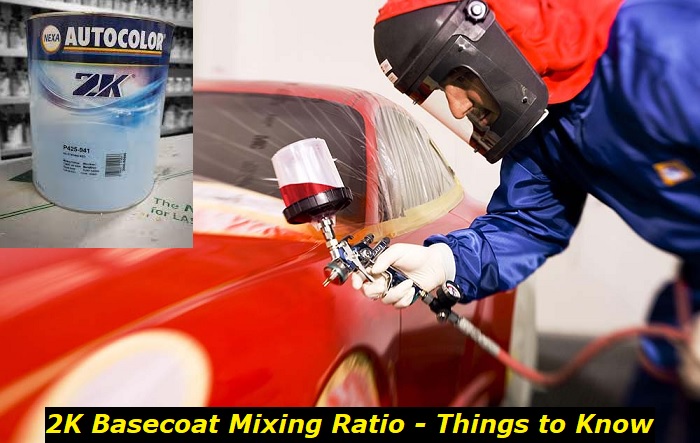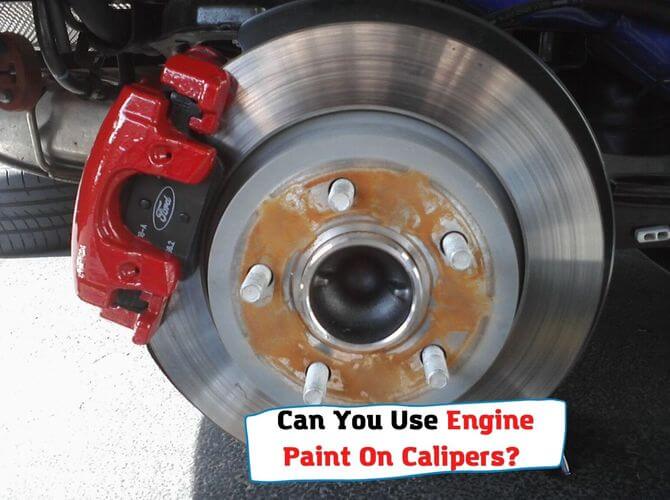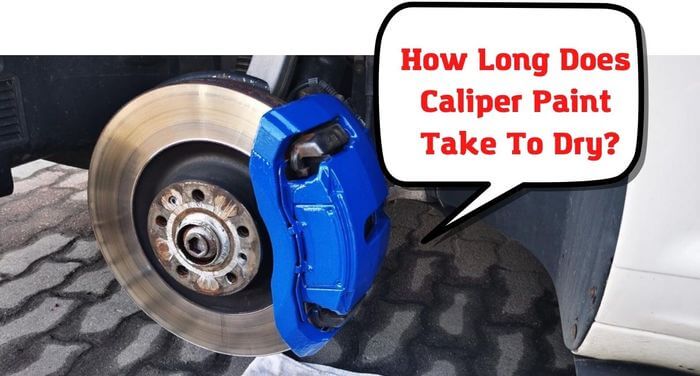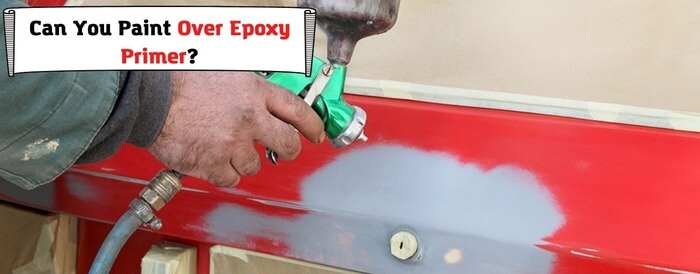When it comes to finishing vehicles, nothing comes close to 2K basecoat paints. But while these are often more durable than 1K basecoats, they can be tricky to apply. One of the biggest challenges you’ll face is learning about the mixing ratio.
Even the slightest deviation can compromise the quality of your finish. And once you understand how to prepare it successfully, you’ll still need to apply it. This can feel overwhelming, especially if you’ve never done it before. Luckily, we have several useful tips and tricks that will guide you through this process.

We prepared this article to teach you the following about 2K basecoat paints:
- What they are
- Why they’re useful
- What the mixing ratio means
- Whether they’re safe or not
- How to apply them
What is a 2K basecoat paint?
A 2K basecoat is a type of paint made of 2 different parts. The ‘2K’ part at the beginning stands for two-component. This type of paint is popular especially when it comes to finishing cars and other vehicles.
These two parts are the paint itself and an activator or hardener.
The basecoat part consists of pigment and other additives. These components are responsible for giving the paint its desired color. The activator/hardener is a substance that chemically bonds to the paint, making it stronger and more durable. This makes 2K paints much longer lasting than their 1K counterparts.
What makes 2K Basecoat paints so good? 3 pros of using them
Although applying 2K basecoat paints can be trickier, they offer several advantages over their 1K counterparts. Here are 3 benefits of using them:
1) They’re more durable
The main appeal of 2K basecoat paints lies in their durability. The hardener reinforces the paint, making it much more resistant to both physical and chemical elements. Thus, they resist adverse weather conditions much better.
Most 2K basecoat paints resist corrosion as well.
If applied properly, these paints can also prevent scratching, chipping, and even fading.
2) They look better
2K basecoat paints tend to look better. Since the paint is separated from the hardener, manufacturers can design the color much more precisely. Thus, you’re much more likely to get your desired color when applying it.
The paints are generally brighter and glossier as well.
3) They’re more practical
Using a 2K basecoat paint is a walk in the park once you learn how to mix it. The paint dries much faster thanks to the hardener, which can save you a lot of time. Moreover, it sticks to the surface much better.
You can use a 2K basecoat on many surfaces, including metal, fiberglass, and plastic.
What is the 2K basecoat mixing ratio?
A 2K basecoat paint consists of two parts. These come separately, meaning you must mix them yourself before you apply the base coat.
The ratio refers to how much color coat you should mix with the activator or hardener to create the final paint. Each product has its specific ratio and you can find it on the label.
One common ratio is 4:1. This would mean mixing 4 parts color with 1 part hardener. If you had 500 ml of a 2K basecoat, you’d have to mix 400 ml of the paint with 100 ml of hardener.
Some 2K basecoat paints can have percentages written after the ratio. For instance, you can see 2:1 + 10%-20%. This percentage refers to how much thinner you should use. Choose an amount based on how diluted you want the paint to be.
Are 2K basecoat paints safe to use?
While 2K basecoat paints are safe to use, they contain many chemicals just like any other type of paint. Thus, you need to wear protective equipment while you handle them.
Direct exposure to 2K paints can lead to skin irritation and even respiratory issues.
They’re not the safest for the environment either. Once you’re done with them, make sure you dispose of the waste responsibly.
How to apply a 2K basecoat paint – 6 useful tips and tricks
The benefits of a 2K basecoat paint come with one drawback – the process can be much more complicated. Luckily, we prepared this simple guide that will help you apply it successfully.
Here are 6 useful tips and tricks for applying a 2K basecoat paint:
1. Always wear protective equipment
Like most paints, the 2K basecoat contains many harmful chemicals. Direct skin contact can lead to irritation and other health complications. You shouldn’t inhale the fumes either. Thus, we recommend wearing a full bodysuit when handling a 2K basecoat paint. Some of the most crucial pieces are protective goggles and masks.
2. Prepare the surface
Before you begin applying the 2K basecoat paint, you must first prepare the surface. Otherwise, the paint won’t stick to it well.
The first step is to sand the surface. This will clean most of the dirt and other impurities and prepare the surface for painting. Make sure you de-grease it as well. Grime and oil might repel the paint, making it slide down from the surface.
3. Prepare the 2K basecoat paint
With the surface polished, it’s time to move on to preparing the mixture. Check the ratio on the label of your 2K basecoat paint. Some common ones include 2:1, 3:1, and 4:1. Make sure to add a thinner as well if you need to dilute the paint. You can find the recommended percentage for your paint on the label as well. Make sure the 2K basecoat is at room temperature before you mix it.
You have two methods for handling the mixing process.
The first and most precise one is using a precision weighing scale. Simply set the container on the scale and set it to zero. Then, slowly add the paint until you reach the weight determined by the ratio. Do the same with the activator and mix them. Stir it well and let it sit for a minute or two for the best results.
However, digital scales can be costly investments. You can alternatively combine the two based on volume. All you need are two measuring containers. While this is slightly less accurate, it’s also much cheaper.
4. Prepare the spray gun
Next, you’ll need to prepare the spray gun. Your 2K basecoat paint should have the recommended pressure written on the label. Make sure you choose the correct nozzle opening as well. If you don’t, you’ll likely get an uneven finish.
Keep in mind that spray guns are not where you want to cut your budget. Low-quality spray guns create a haphazard finish and lead to poor results. Make sure you’re using a clean spray gun. Debris and other impurities can impact the flow and thus the quality of your work.
5. Apply the 2K basecoat paint
With your spray gun all set up, it’s time to apply the 2K basecoat paint. To achieve the best results, make sure you follow these principles.
Test the paint on a small piece of cardboard first. Make sure it flows in a thin, steady pattern. If it doesn’t, you might need to adjust your spray gun again.
When you start applying the 2K basecoat paint on your desired surface, make sure you maintain even distance and pressure the whole time. Otherwise, the coat won’t be even, and you’ll have to redo it.
Pay extra attention to the sides. The basecoat doesn’t stick as well to these, which may tempt you to use more of the product. Make sure you don’t overdo it or it will create spots of sagged paint which can be tricky to remove.
6. Clean your equipment once you’re done
Although the feeling of finishing your painting project can be very satisfying, your job doesn’t end here. Always clean your equipment once you’re done. This will prevent the paint from drying inside components such as the spray gun. Dried paint can lead to uneven flow during future projects, which can affect your overall performance. It will also decrease your equipment’s longevity.
Our final thoughts on 2K basecoat paints
As the name suggests, 2K basecoat paints are made of two components –pigment and hardener. These paints are popular especially when it comes to finishing vehicles. This is because they’re much more durable than their 1K counterparts. They provide a brighter, glossier finish as well.
However, using a 2K basecoat paint can be tricky. If you don’t prepare it properly, you may end up ruining your project. Each product comes with a specific ratio. This refers to how much basecoat you need to mix with hardener to prepare the final product. Consider aiming for 1000 ml of product with a 3:1 ratio. In this case, you’d want to mix 750 ml of basecoat with 250 ml of hardener.
In some cases, you can add a thinner based on the percentage written on the label.
But before you begin, make sure you sand and clean the surface on which you want to apply it. Otherwise, it won’t stick to it as well. Use a quality spray gun and maintain a steady distance and pressure during the whole process. Always clean your tools after you’re done to prolong their lifespan.
Follow these tips and you’ll achieve your desired finish even if you’ve never used a 2K basecoat before.
- Can You Unmix Paint: Techniques, Consequences, Alternatives - February 23, 2024
- Does Primer Need to be Mixed? Effective Primer Application - February 22, 2024
- How to Make Old Paint Usable Again: Retrieving and Preserving Paint - February 21, 2024



